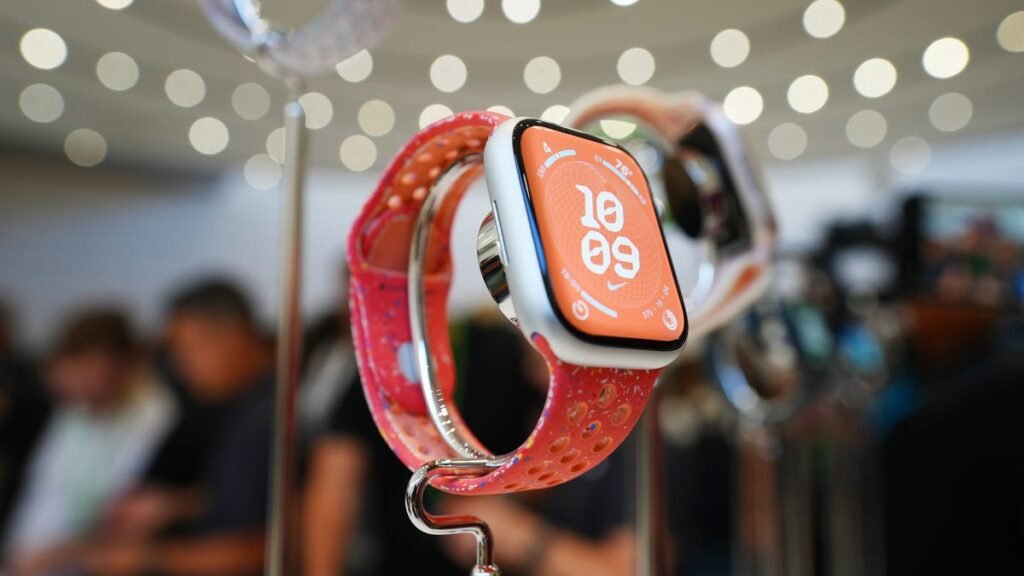In many ways, the advent of Double Tap to Apple Watch Series 9 and Apple Watch Ultra 2 exemplifies the oft-repeated notion that accessibility is for everyone. For one thing, it’s my understanding that Double Tap, like iPadOS cursor support a few years ago, was something that grew from its natural origins in AssistiveTouch on watchOS. To wit, the Accessibility team within Apple passed the proverbial baton to the main watchOS group in order to adapt the feature for a wider, more mainstream audience. For another thing, that Apple is marketing Double Tap as an interface paradigm to rely on when one’s hands are full is quintessential accessibility despite the company’s proclamations in describing it as magical and convenient—it’s definitely the latter.
Along with the iPhone 15 models, Apple sent me a Series 9 review unit following the company’s September event. As my preferred Apple Watch is the 49mm Ultra, I only tested the smaller 45mm Series 9 for the express purpose of trying out Double Tap, which shipped with last month’s watchOS 10.1 update. In a nutshell, I can report it works as advertised. To expound, it technically wasn’t my first go-round with Double Tap. Following the September keynote, I got to spend about five minutes with Double Tap in the hands-on area for members of the media. At the time, I distinctly recall having some trouble getting the tap gesture to register after an Apple employee tried “calling” me. I couldn’t deduce whether the problem was with my lack of motor ability or with buggy pre-release software, but it definitely took me a few tries to accept and end the phone calls, not to mention pausing and playing music.
Still, I left the demo table impressed as the concept was so rock solid.
Fast-forward several weeks later and I’m still impressed by Double Tap today. Almost a decade into Apple Watch life, I’m unembarrassed to admit to heretofore bringing my wrist close to my nose in order to tap a button when my hands were busy. As I noted, Double Tap is the sort of de-facto accessibility feature so prevalent in Apple’s panoply of platforms—Apple Pay is another, two-factor authentication codes in Messages another still—that is designed for the mainstream but truly is designed to be assistive. As I noted in the lede, Double Tap is the embodiment of the notion that accessibility truly is for everyone.
As a practical matter, using Double Tap, while indeed magical and useful, does fall down for me at times. It isn’t that the software is buggy or failing as much as its my own motor conditions. To wit, the suspicion I had back in September about Double Tap not working in the demo partly due to my disability was absolutely not an aberration. I have partial paralysis running the entire length of the right side of my body due to cerebral palsy. Being a southpaw, I wear my Apple Watch on my right wrist. You see the conundrum there. Every time I invoke the Double Tap gesture, the muscles in my fingers and hand have to work overtime because they’re so atrophied. Likewise, the low muscle tone I have in said fingers and hand means sometimes the gesture doesn’t register at first; I need to do it once, maybe twice, more. Again, not a failing of watchOS but nonetheless dampening to the user experience for me. I can perform the gesture in an absolute sense, but it’s the process of doing it that’s problematic. Relatedly, it makes me wonder how well I’ll be able to select items in visionOS; my intuition tells me I may have to rely on an accessibility feature for the headset much like I must leave Require Attention disabled in order to use Face ID on my iPhone.
Finally, a cursory note on Series 9’s display. As a devout Ultra wearer, it was a shock to my system to go back to the relatively minuscule display on the regular Series 9. Prior to the Ultra’s advent last year, I wore the 42/44/45mm size Apple Watch for years and enjoyed it very much. Now, a little over a year with the Ultra, it was quite the adjustment for my eyeballs to use the smaller screen. As a longtime iPhone Plus/Max user, it’s the same way I feel when I use a regular-sized iPhone. Both the Watch and iPhone have good screens, but it goes to show the adage that “bigger is better” truly does make a difference for devices like this. After adjusting to the max size on these products, it’s hard to go back to anything else even if they are with review units meant for testing purposes. As long as Apple offers an iPhone Pro Max and an Apple Watch Ultra, I will choose those precisely because of their large screens.
As for Double Tap, I’m enthusiastic about it but not rushing to upgrade for it. My Apple Watch Ultra is last year’s version, the original one, and still works great. However well done Double Tap is, I’m dubious as to whether this one feature is worth upgrading for when everything else about the new Ultra essentially remains unchanged from the one I have.
It’s a fitting for someone writing these words on a 4-year-old Intel iMac.
Source: Read More Author:


